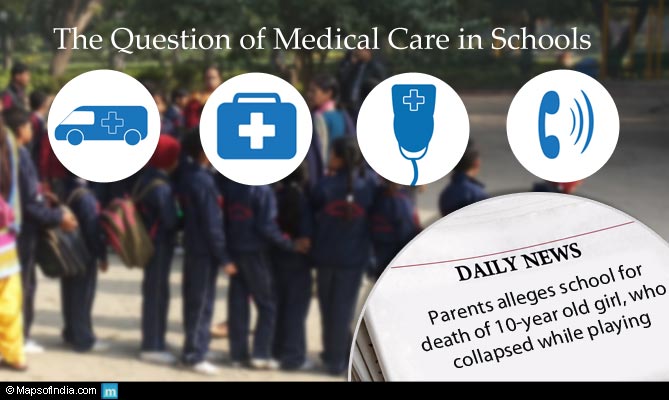 A child with mild mental retardation is playing in her school with friends. The see-saw that she is on is rickety and defective. It gives way, and the child has a nasty fall, injuring her face severely. The school is unaware of how to handle the incident and calls the parents. The child is rushed to a nearby medical facility and is admitted for several days. The parents allege that medical care was not provided on time, and that the school authorities did not visit the hospital or provide support of any kind.
A child with mild mental retardation is playing in her school with friends. The see-saw that she is on is rickety and defective. It gives way, and the child has a nasty fall, injuring her face severely. The school is unaware of how to handle the incident and calls the parents. The child is rushed to a nearby medical facility and is admitted for several days. The parents allege that medical care was not provided on time, and that the school authorities did not visit the hospital or provide support of any kind.- A 10-year old girl, with a previous history of congenital heart disease falls down in the school during play time. The school makes her lie down and does not call for any medical help. The parents are called, and are told that she ‘collapsed while playing’. The girl is rushed to a hospital where she is declared ‘brought dead’. The school accuses the parents of not taking care of her heart condition. The parents say that she had had a recent medical check-up, which was normal. They allege that the school mismanaged the whole incident and tried to fudge the post-mortem examination report.
The above real life incidents are a grim reminder of lack of medical facilities in our schools. This is a highly neglected area, one that school managements, teachers, parents and policy-makers often ignore. It takes only one adverse incident such as any of the two described above for everybody to pass the buck and absolve oneself of all responsibility.
Had there been mechanisms in place for ensuring the health and safety of children attending school, the situation would not have been as bad as what we are faced with today. Particularly, in the wake of recent spurt in child abuse cases, the parents, schools and governments have a collective responsibility of making sure that the children are provided with a safe learning environment.
While accidents during play and medical problems in children are an inevitable part of early childhood, it is their management that is faulty. Often schools do not stock first-aid equipment or basic medication. In most cases, schools are also not attached to a medical establishment of any sort.
There is a tacit understanding that the parents are responsible for all medical issues, while the school is concerned only with imparting education. If and when there is an adverse event such as an accident or abuse of the child while on school premises, there is an unfortunate tendency on the part of school management to hush things up.
Sorry, this cannot be acceptable. A school is a place where parents send their children with the hope that they would receive quality education in a safe environment. It is the school’s responsibility to ensure that such an environment is provided for the child. Don’t they collect extra remuneration, ostensibly for ‘building funds’ even at the time of admission? Besides, parents would be more than willing to shell out an extra buck if it is needed for maintaining safety and security of their children.
In such an environment, it is heartening to note that there exists a programme run by an NGO that looks to improve the health of schoolchildren across the country. The School Health Annual Report Programme (SHARP) is a Delhi-based agency that arranges for medical check-up of schoolchildren at empanelled hospitals, with the help of corporates (as part of their corporate social responsibility) and world organisations. This needs to be taken up nationwide, particularly in the rural schools where children from lower socio-economic backgrounds attend, and are more prone to ill-health.
What can be done to address this urgent and neglected issue? The following, though not a comprehensive list, may provide a start:
- Parents can start by checking the school atmosphere, equipment and environment. They should enquire about the health care facilities right at the time of admission. They can write to the school management about any deficiencies that they observe, or if they want to suggest an improvement; most schools entertain an active role by parents.
- Parents should provide the school with the details of their child’s medical condition and its treatment, which may include administering medication at regular intervals.
- Schools should ensure that sports and games equipment are regularly checked, and first-aid items/medicines are updated. Named staff members from the school should be given responsibility to ensure this happens.
- Every school should have an association with nearby medical establishments, particularly those with casualty, orthopedic and pediatric facilities. The names of these places should be provided to the parents.
- Special schools which cater to the needs of children with mental and physical disabilities should have a multi-disciplinary team comprising, in addition to occupational therapists, physiotherapists and speech & language therapists; nurses or health care facilitators too. Special schools should be equipped with a basic on-site clinic and should be closely situated to a medical facility.
- Schools should be encouraged to enroll with NGOs such as SHARP so that children’s health can be regularly monitored with consent from the parents.
- There should be regular independent audits on health and safety measures in schools. Any school that is regularly deficient in health and safety issues should have its licence cancelled.
- The only way to ensure that these measures are implemented is if the Government could make this a mandatory requirement for all schools.
- Activism and advocacy by the public and NGOs would go a long way in achieving the dream of a healthy and safe environment for our children.
Read more:
Green Tea: Types, Benefits and Side Effects
How to Prevent Hair Loss in 10 Tested Ways?
Discover Which Type of Yoga Suits You?
Natural Drinks and Foods for Liver Detoxification
Home Remedies to Stop the Signs of Ageing




